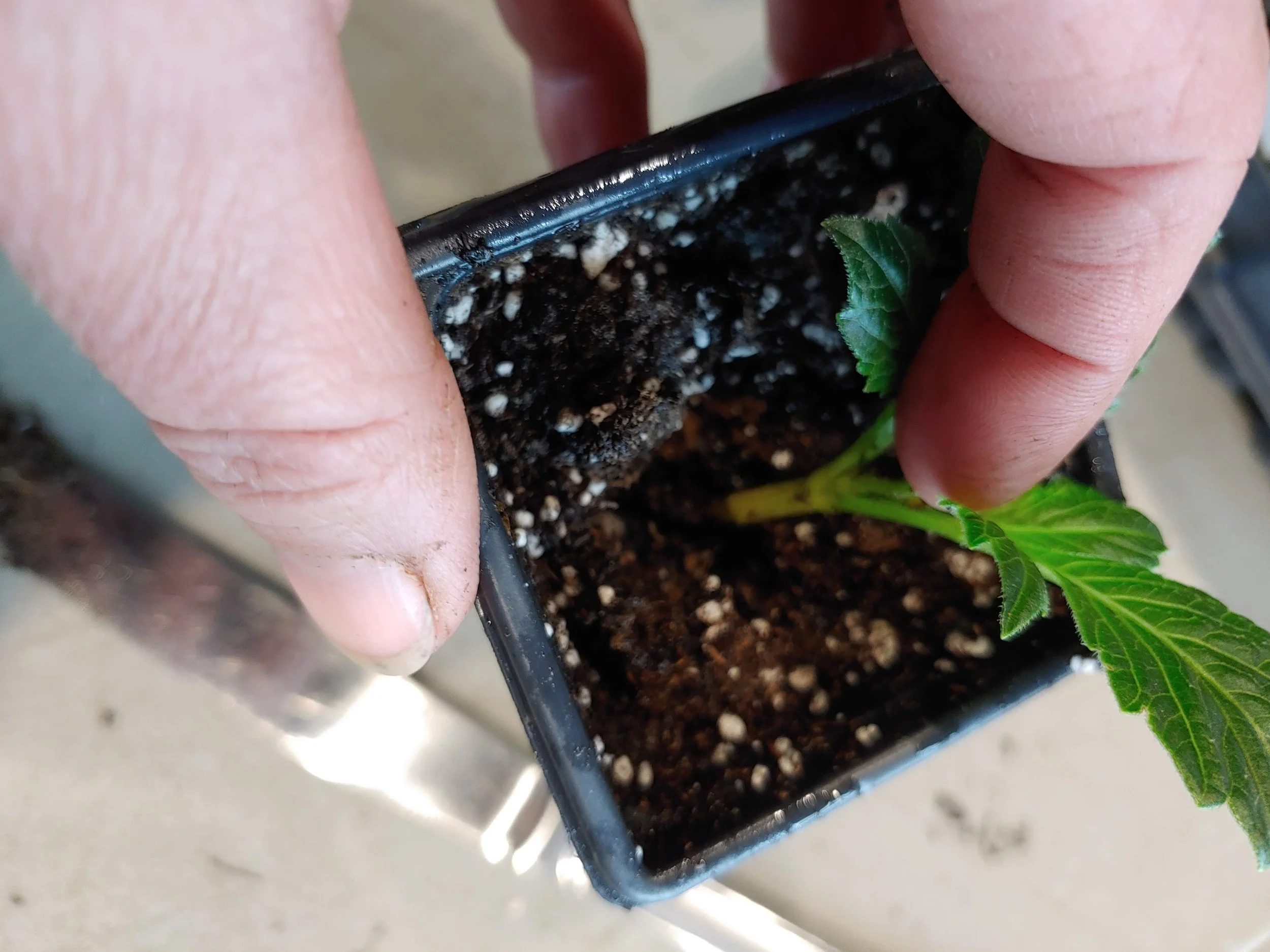By this point, you’ve potted up your tuber, it’s sprouted and you’ve taken your first cuttings. They’ve been stuck in the rooting medium for a few weeks now.
So it’s time to pot them up. This is probably the easiest and least mystifying part of this whole process. If you’ve made it this far, you’re almost home free!
I like to use small pots- anywhere from a 3” to 5” size. Larger if it’s earlier in the season and the cutting will be growing out longer.
Take your cutting tray and gently pull at each sprout. If you feel resistance like you can’t easily pull it out— chances are that it has some roots. I like to use a butter knife to get them out of the plug tray. (if you used a small pot to begin with you can skip the potting up stage).
The cutting on the left has the minimum amount of roots that I want to see before I begin potting up. The cutting on the right needs another week.
Place some good potting mix in your pot, and then hollow out a small depression- about as deep as your plug tray cell. Dig the cutting- roots and all out of the tray with the butter knife. Make sure you’ve got decent roots on it— like a few white fat roots- 2-3” long. if the roots are tiny, give it another week before planting up.
Pop it into the depression in your pot, gently pat a bit of soil around it to stabilize it and firm it in. Water gently and thoroughly— It’s important that the roots and the surrounding soil have an even wetness at this stage. You don’t want any dry soil pockets or huge air pockets around your roots. Good soil to root contact!
Don’t forget to transfer your label from the plug tray!
Place the pot back on your heat mat if using and under your grow lights for another few weeks. Once it’s fully rooted into your pot, then transition it outside and begin to harden it off. If you are frost free, you can place under the grow lights for a few days and then finish the growing period outside.
To harden off, place the plant in a shady spot for a few days, then gradually move it to more sun. The process usually takes about a week.
After you’ve hardened off your plant and you are frost free for the season, it’s time to plant your dahlia in the garden!!
Congrats you’ve successfully multiplied your dahlias! And who doesn’t want more dahlias!!
BTW— Most likely that cutting is going to produce flowers faster than the tuber!
Also- you can still plant your tuber even after you’ve taken cuttings off it. I like to let them re-sprout to a few inches tall and then plant like normal.
Buying Rooted Cuttings:
Since buying dahlias as rooted cuttings is becoming more and more of a “thing” I thought it would be a good idea to discuss the process of how to handle them.
You’ll receive in the mail a small plant that has been rooted into a plug size rooting medium- may be a potting mix, an elle pot, or possibly formed peat moss plug often called Root Riots (shown below). Upon arrival, you’ll want to pot these up- do this within 24 hours, the sooner the better. If you have to wait a day, make sure the plugs are staying moist.
There may even be some yellowing leaves at the bottom of the plug- that’s okay. The plant has used what it needed from those- just remove them. Also it may have curved a bit while in the box- it’ll straighten out.
After potting up into a small pot (like the process described above), place the cutting out of strong light- remember it’s been in a box. You need to harden it off gradually and re-acclimate it to the light. You can place it under grow lights if it’s still cold outside or grow it on outdoors if weather permits. You’ll need to grow it on about 3-4 weeks depending on your pot size before planting into the garden.
Fertilizer- it’s important to fertilize your cuttings. They’ve been growing in a very small amount of space and have most likely exhausted the food in their plug so give them some love. A fertilizer high in nitrogen and a bit of phosphorus and potassium- a good liquid feed will work.
After you’ve got a fully rooted plant, it’s time to plant in your garden. Dig a hole- a bit deeper than your pot. You want to remove the lowest pair of leaves on your plant. Then plant it deep enough so that the node where those leaves where is underground. This will increase the number of tubers you get off the plant. (And yes it will form tubers and bloom in year 1).
You’ll see flowers around 2-3 weeks faster from a rooted cutting b/c they have a bit of a head start over a planted tuber.





























